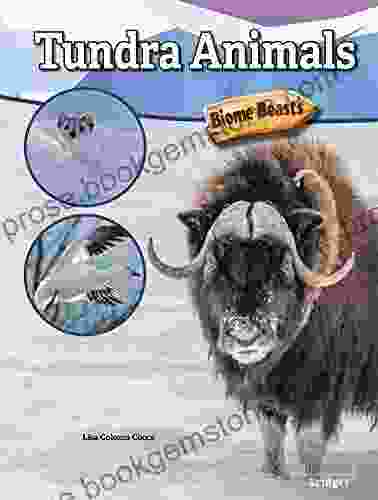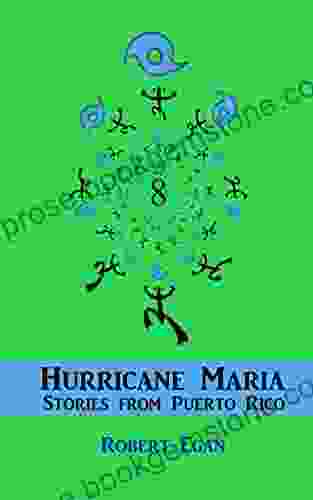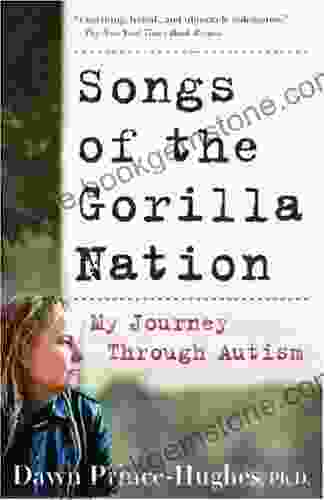Tundra Animals: Guided Reading Level Biome Beasts

The tundra is a vast, cold, and treeless region that stretches across the northernmost parts of North America, Europe, and Asia. It is a harsh and unforgiving environment, but it is also home to a wide variety of animals that have adapted to survive in this extreme climate.
What is the Tundra?
The tundra is a treeless region that is characterized by its cold climate, low precipitation, and permafrost. Permafrost is a layer of soil that remains frozen all year round. The tundra is divided into two main types: the Arctic tundra and the Antarctic tundra.
4.7 out of 5
| Language | : | English |
| File size | : | 5167 KB |
| Screen Reader | : | Supported |
| Print length | : | 32 pages |
The Arctic tundra is located in the northernmost parts of North America, Europe, and Asia. It is characterized by its cold climate, with average temperatures below freezing for most of the year. The Arctic tundra is also very dry, with annual precipitation of less than 10 inches.
The Antarctic tundra is located on the continent of Antarctica. It is characterized by its even colder climate, with average temperatures below freezing all year round. The Antarctic tundra is also very dry, with annual precipitation of less than 2 inches.
Animals of the Tundra
The tundra is home to a wide variety of animals that have adapted to survive in this extreme climate. These animals include:
- Caribou
- Musk oxen
- Polar bears
- Arctic foxes
- Lemmings
- Ptarmigans
- Snowy owls
li>Snowshoe hares
Caribou
Caribou are large, hoofed mammals that are found in the tundra regions of North America and Europe. They are well-adapted to the cold climate, with thick fur and large hooves that help them to distribute their weight on the snow.
Caribou are herbivores that feed on a variety of plants, including grasses, sedges, and lichens. They migrate long distances in search of food, and they are often seen in large herds.
Musk Oxen
Musk oxen are large, shaggy mammals that are found in the tundra regions of North America and Greenland. They are well-adapted to the cold climate, with thick fur and a large hump on their back that stores fat.
Musk oxen are herbivores that feed on a variety of plants, including grasses, sedges, and lichens. They live in herds of up to 100 individuals, and they are often seen grazing on the tundra.
Polar Bears
Polar bears are large, white bears that are found in the Arctic tundra regions of the world. They are well-adapted to the cold climate, with thick fur and a layer of blubber that insulates them from the cold.
Polar bears are carnivores that feed on seals, walruses, and other marine mammals. They are excellent swimmers and divers, and they are often seen hunting on the sea ice.
Arctic Foxes
Arctic foxes are small, white foxes that are found in the tundra regions of the world. They are well-adapted to the cold climate, with thick fur and a short, bushy tail that helps to keep them warm.
Arctic foxes are opportunistic predators that feed on a variety of small animals, including rodents, birds, and eggs. They are also known to scavenge on the remains of other animals.
Snowshoe Hares
Snowshoe hares are large, white hares that are found in the tundra regions of North America. They are well-adapted to the cold climate, with thick fur and large feet that help them to distribute their weight on the snow.
Snowshoe hares are herbivores that feed on a variety of plants, including twigs, buds, and leaves. They are often seen in large groups, and they are known for their distinctive hopping gait.
Lemmings
Lemmings are small, brown rodents that are found in the tundra regions of North America and Europe. They are well-adapted to the cold climate, with thick fur and a short, stocky body that helps them to retain heat.
Lemmings are herbivores that feed on a variety of plants, including grasses, sedges, and mosses. They are often seen in large groups, and they are known for their tendency to migrate in large numbers.
Ptarmigans
Ptarmigans are small, white birds that are found in the tundra regions of the world. They are well-adapted to the cold climate, with thick fur and a layer of feathers that insulates them from the cold.
Ptarmigans are omnivores that feed on a variety of plants and animals, including seeds, berries, insects, and small rodents. They are often seen in large flocks, and they are known for their distinctive cackling call.
Snowy Owls
Snowy owls are large, white owls that are found in the tundra regions of the world. They are well-adapted to the cold climate, with thick fur and a layer of feathers that insulates them from the cold.
Snowy owls are carnivores that feed on a variety of small animals, including rodents, birds, and fish. They are often seen perched on rocks or trees, and they are known for their distinctive hooting call.
The tundra is a harsh and unforgiving environment, but it is also home to a wide variety of animals that have adapted to survive in this extreme climate. These animals are a testament to the power of evolution, and they play an important role in the ecosystem of the tundra.
4.7 out of 5
| Language | : | English |
| File size | : | 5167 KB |
| Screen Reader | : | Supported |
| Print length | : | 32 pages |
Do you want to contribute by writing guest posts on this blog?
Please contact us and send us a resume of previous articles that you have written.
 Best Book
Best Book Page Flip
Page Flip Bookshelf
Bookshelf Literary loom
Literary loom Chapter
Chapter Bookish
Bookish PageTurner
PageTurner Bibliophile
Bibliophile Story
Story Inkwell
Inkwell Bookworm
Bookworm Labyrinth
Labyrinth Plot Twist
Plot Twist Prose
Prose Paperback
Paperback Storyteller
Storyteller Sanctuary
Sanctuary Fiction
Fiction Reading
Reading Chronicle
Chronicle Read
Read Haytham Al Fiqi
Haytham Al Fiqi Jennifer Julie Miller
Jennifer Julie Miller Dave Pelzer
Dave Pelzer Susan Hill
Susan Hill Oliver La Farge
Oliver La Farge Eric Bravo
Eric Bravo Francene Hart
Francene Hart Michael Lent
Michael Lent Devon C Ford
Devon C Ford Mimi Robinson
Mimi Robinson Michelle Kuo
Michelle Kuo Didier Ghez
Didier Ghez Veronica Lawlor
Veronica Lawlor R Annie Gough
R Annie Gough Shaun King
Shaun King D B Goodin
D B Goodin Carole Angier
Carole Angier Peggy Dean
Peggy Dean Mike Lyon
Mike Lyon Stephen Kohler
Stephen Kohler Bruce T Batchelor
Bruce T Batchelor Jason Diamond
Jason Diamond Carole S Kessner
Carole S Kessner Bryan Miles
Bryan Miles Pearl S Buck
Pearl S Buck Kris Timken
Kris Timken Carol Miller
Carol Miller Carsten Wieland
Carsten Wieland Camelia Elias
Camelia Elias Cat Seto
Cat Seto Brad Leone
Brad Leone Bruce Kennett
Bruce Kennett Kay Bratt
Kay Bratt Marcia Iwatate
Marcia Iwatate Mynor Schult
Mynor Schult Carolyn J Brown
Carolyn J Brown Eve Laplante
Eve Laplante Brandon Webb
Brandon Webb C V Walter
C V Walter Bryce W James
Bryce W James Tony Bartelme
Tony Bartelme Robert L Forward
Robert L Forward Catherine Craft
Catherine Craft Catherine Kerrison
Catherine Kerrison Sara Alm
Sara Alm Emiko Ohnuki Tierney
Emiko Ohnuki Tierney Timothy Zahn
Timothy Zahn Tasha Black
Tasha Black Janice Seto
Janice Seto Dianne Hales
Dianne Hales George Alec Effinger
George Alec Effinger Emily Sturgill
Emily Sturgill Clayton Graham
Clayton Graham Graham Mackintosh
Graham Mackintosh Joe R Frinzi
Joe R Frinzi Jack L Roberts
Jack L Roberts Yolanda Hadid
Yolanda Hadid Carolyn Schulz
Carolyn Schulz Brittany K Barnett
Brittany K Barnett Zitkala Sa
Zitkala Sa Michael Jacobs
Michael Jacobs Suzette D Harrison
Suzette D Harrison Carrie Fisher
Carrie Fisher Bell Hooks
Bell Hooks Melissa R Klapper
Melissa R Klapper Buie Harwood
Buie Harwood Deborah Ball
Deborah Ball Heriberto Padilla
Heriberto Padilla M R Forbes
M R Forbes David Kalat
David Kalat Darla Mayberry
Darla Mayberry Bradford Pearson
Bradford Pearson Carolina Rose
Carolina Rose Tanya Lapointe
Tanya Lapointe Carol Belanger Grafton
Carol Belanger Grafton Rabbi Lynnda Targan
Rabbi Lynnda Targan John Wagner
John Wagner Sheri S Tepper
Sheri S Tepper Victor Manibo
Victor Manibo John Logan
John Logan Brian Lawrenson
Brian Lawrenson Kimolisa Mings
Kimolisa Mings John Clites
John Clites Wayne Mardle
Wayne Mardle Bradford Bates
Bradford Bates Craig Anderson
Craig Anderson Christy Brown
Christy Brown Jenny Volvovski
Jenny Volvovski Rheni Tauchid
Rheni Tauchid Kelsey Oseid
Kelsey Oseid Kai Kupferschmidt
Kai Kupferschmidt Maria Holderbaum
Maria Holderbaum Edgardo Cozarinsky
Edgardo Cozarinsky William T Vollmann
William T Vollmann George R R Martin
George R R Martin James Tate Hill
James Tate Hill C M Carney
C M Carney Liron Yanconsky
Liron Yanconsky Burst Books
Burst Books Carol Bolt
Carol Bolt James Mcbride
James Mcbride Gail Grant
Gail Grant Cathy Johnson
Cathy Johnson Kimi Cunningham Grant
Kimi Cunningham Grant Carl Hiaasen
Carl Hiaasen Booker T Washington
Booker T Washington Dl Acken
Dl Acken Catherine Porter
Catherine Porter Renee Rose
Renee Rose Dave Walsh
Dave Walsh Gary Chandler
Gary Chandler Brian Seidman
Brian Seidman Carlos Francisco Jackson
Carlos Francisco Jackson Lincoln Child
Lincoln Child June Foray
June Foray Robert Noble Graham
Robert Noble Graham Tananarive Due
Tananarive Due Sabeeha Rehman
Sabeeha Rehman Joe Palermo
Joe Palermo Keisha J
Keisha J Timon Screech
Timon Screech J T Skye
J T Skye Kate Fullagar
Kate Fullagar William Hogarth
William Hogarth Bwwm Love
Bwwm Love Brian C Hailes
Brian C Hailes Lacy Crawford
Lacy Crawford Joel Shepherd
Joel Shepherd James O Reilly
James O Reilly John Waters
John Waters James N Yamazaki
James N Yamazaki Leanne Howe
Leanne Howe Frederick Joseph
Frederick Joseph Dana Mahan Jr
Dana Mahan Jr Brian Harker
Brian Harker Susan Kennedy
Susan Kennedy Lauren Kessler
Lauren Kessler Brian Dougherty
Brian Dougherty Kellee Wynne Conrad
Kellee Wynne Conrad Cheryl Burke
Cheryl Burke Brian Broome
Brian Broome Josh Malerman
Josh Malerman Bruce Bradley
Bruce Bradley Jerry Remy
Jerry Remy Mike Gayle
Mike Gayle Carolyn Birrell
Carolyn Birrell Tad Crawford
Tad Crawford Pyae Moe Thet War
Pyae Moe Thet War Robert Barr Smith
Robert Barr Smith Mz Creates
Mz Creates Nikqua
Nikqua Kelly Kordes Anton
Kelly Kordes Anton Stephen Mertz
Stephen Mertz Dessy Tsolova
Dessy Tsolova Paul E Fallon
Paul E Fallon Mark Greenside
Mark Greenside Erik Stafford
Erik Stafford Dolly Parton
Dolly Parton Jillian Vose
Jillian Vose Mary Stuart
Mary Stuart Scott Finazzo
Scott Finazzo Carmen Reid
Carmen Reid Joe Ide
Joe Ide Brandon Q Morris
Brandon Q Morris David L Sloan
David L Sloan Herbie J Pilato
Herbie J Pilato Michael Hingson
Michael Hingson Danielle Bernstein
Danielle Bernstein Chronicle Books
Chronicle Books Eufrasia Gagliardo
Eufrasia Gagliardo Donna Digiuseppe
Donna Digiuseppe Mark Arnold
Mark Arnold Lucy R Lippard
Lucy R Lippard Mira Jacob
Mira Jacob Sallust
Sallust Tamar Arslanian
Tamar Arslanian Paul Chiasson
Paul Chiasson Vaughn Heppner
Vaughn Heppner Brian Ashcraft
Brian Ashcraft Carlyn Beccia
Carlyn Beccia Bruce Baird
Bruce Baird Maya Jasanoff
Maya Jasanoff Peter Moruzzi
Peter Moruzzi Stuart Kendall
Stuart Kendall Caroline Knapp
Caroline Knapp Noell K Wolfgram Evans
Noell K Wolfgram Evans Carrie Cariello
Carrie Cariello Bruce Sutherland
Bruce Sutherland Taniece
Taniece Rachel Felder
Rachel Felder Brando Skyhorse
Brando Skyhorse Casey Diaz
Casey Diaz Dean Foster
Dean Foster Janet Whittle
Janet Whittle Camille Laurens
Camille Laurens Perry Buck
Perry Buck Mara Jaye
Mara Jaye David Steffen
David Steffen Connie Fleenor
Connie Fleenor Mineko Iwasaki
Mineko Iwasaki Shane Lochlann Black
Shane Lochlann Black Linda Grant
Linda Grant Norberto Chaves
Norberto Chaves Kimberlee Yolanda Williams
Kimberlee Yolanda Williams Paul Clammer
Paul Clammer Paul Reps
Paul Reps Kateri Ewing
Kateri Ewing David Ryan
David Ryan C Shortt
C Shortt Peter Mutabazi
Peter Mutabazi Brian Herbert
Brian Herbert Burton Bernstein
Burton Bernstein Gerald S Strober
Gerald S Strober Marie Arana
Marie Arana Yuwanda Black
Yuwanda Black Julia Sherman
Julia Sherman Jennifer Smith Turner
Jennifer Smith Turner Peter Cawdron
Peter Cawdron Lincoln Cushing
Lincoln Cushing Niall Williams
Niall Williams Parshwika Bhandari
Parshwika Bhandari Murry E Page
Murry E Page S K Dunstall
S K Dunstall Brian Ladd
Brian Ladd Cain Carroll
Cain Carroll Howard Schultz
Howard Schultz David Sayers
David Sayers Iris Scott
Iris Scott Delaney Diamond
Delaney Diamond John Berger
John Berger Brady J Crytzer
Brady J Crytzer Camilla Townsend
Camilla Townsend Michael Frary
Michael Frary Rosalind Rosenberg
Rosalind Rosenberg Capt Ron Nielsen
Capt Ron Nielsen James Steffen
James Steffen Tj Silverlake
Tj Silverlake Carly Murden
Carly Murden Caroline Scott
Caroline Scott Relaxed Venues
Relaxed Venues Donald Keene
Donald Keene Linda Przybyszewski
Linda Przybyszewski Tim Hannigan
Tim Hannigan Griff Hosker
Griff Hosker Lisa Fenn
Lisa Fenn Brian Borgford
Brian Borgford Daniel Arenson
Daniel Arenson Sven Lindqvist
Sven Lindqvist Caseen Gaines
Caseen Gaines S C Eston
S C Eston Shirish Deshpande
Shirish Deshpande Russell Maddicks
Russell Maddicks Brian Seibert
Brian Seibert Bryon Macwilliams
Bryon Macwilliams Brian Evans
Brian Evans Jan Grue
Jan Grue Ernesto Mallo
Ernesto Mallo Butch Hartman
Butch Hartman Thomas S Abler
Thomas S Abler Ken Lozito
Ken Lozito D L Young
D L Young Robert Lamouroux
Robert Lamouroux Mark Lewis
Mark Lewis Gretchen M Baker
Gretchen M Baker David Crow
David Crow Brittney C Cooper
Brittney C Cooper Lisa Colozza Cocca
Lisa Colozza Cocca Janice Oberding
Janice Oberding Remco Ensel
Remco Ensel Candy Moore
Candy Moore Brian Hicks
Brian Hicks Michelle Burford
Michelle Burford Mike Jack Stoumbos
Mike Jack Stoumbos Dennis Tupicoff
Dennis Tupicoff John Campbell
John Campbell Walter Mosley
Walter Mosley Carolyn Brown
Carolyn Brown Maud Guilfoyle
Maud Guilfoyle Terrence K Williams
Terrence K Williams Cal Patch
Cal Patch Eddie Jaku
Eddie Jaku Kirsten Pai Buick
Kirsten Pai Buick Paul Smith
Paul Smith Brenda Ferguson Hodges
Brenda Ferguson Hodges Carrie Summers
Carrie Summers Charlene Mciver
Charlene Mciver Brette Sember
Brette Sember Scaachi Koul
Scaachi Koul Reyna Grande
Reyna Grande Steven V Roberts
Steven V Roberts Gene H Bell Villada
Gene H Bell Villada Marcos Enrique Ruiz Rivero Ii Aviel
Marcos Enrique Ruiz Rivero Ii Aviel Brontez Purnell
Brontez Purnell Daniel J Sharfstein
Daniel J Sharfstein Jeffrey Ross
Jeffrey Ross D J Conway
D J Conway Vladimir Sorokin
Vladimir Sorokin Peter Razor
Peter Razor Peter Rhee
Peter Rhee Sarah Jane Downing
Sarah Jane Downing Ella Maven
Ella Maven Luca Somigli
Luca Somigli Milo James Fowler
Milo James Fowler Dawn Prince Hughes
Dawn Prince Hughes Caren Schnur Neile
Caren Schnur Neile Robin Capon
Robin Capon Jane Urquhart
Jane Urquhart G L Carriger
G L Carriger Gaston Migeon
Gaston Migeon Charles Earl Bradbury
Charles Earl Bradbury Meena Alexander
Meena Alexander Cassie Dandridge Selleck
Cassie Dandridge Selleck Gary Gibson
Gary Gibson David Gilmore
David Gilmore Daphne Jenkins Sheldrick
Daphne Jenkins Sheldrick Eric Walters
Eric Walters Robbie Freeman Shugart
Robbie Freeman Shugart Bruce Schoenfeld
Bruce Schoenfeld Russell Harris
Russell Harris Dwayne Walker
Dwayne Walker Brooke Hayward
Brooke Hayward Eric Grzymkowski
Eric Grzymkowski Sonia Cheadle
Sonia Cheadle Lonely Planet
Lonely Planet Leigh Ann Gale
Leigh Ann Gale Ken Steele
Ken Steele Sara Rudin
Sara Rudin Jennifer Niven
Jennifer Niven Ian Olio
Ian Olio Carol A Krejci
Carol A Krejci Brian Smith
Brian Smith Catherine Gill
Catherine Gill Niobia Bryant
Niobia Bryant Vrasidas Karalis
Vrasidas Karalis K Wan
K Wan Toni Braxton
Toni Braxton Mario Puzo
Mario Puzo Tom Hayden
Tom Hayden Tom Bergeron
Tom Bergeron Rafael De Grenade
Rafael De Grenade Ednor Therriault
Ednor Therriault Caroline Johnson
Caroline Johnson Jacques Vankirk
Jacques Vankirk Max Vance
Max Vance Victoria Smith
Victoria Smith C B Griesbach
C B Griesbach Olivia Riley
Olivia Riley Tim Jeal
Tim Jeal Nicolas Rothwell
Nicolas Rothwell Kevin Winkler
Kevin Winkler Magnus Reid
Magnus Reid K G Crawford
K G Crawford Karl Fulves
Karl Fulves Leo Buijs
Leo Buijs Brit Bennett
Brit Bennett C White Foss
C White Foss Richard Mayhew
Richard Mayhew Byron Comstock
Byron Comstock Bridget Conor
Bridget Conor Olivia De Havilland
Olivia De Havilland Mateus Batista
Mateus Batista Catherynne M Valente
Catherynne M Valente Karma Waltonen
Karma Waltonen C H Duryea
C H Duryea Parvati Sharma
Parvati Sharma Brandon Massey
Brandon Massey Sister Dang Nghiem
Sister Dang Nghiem Polly Evans
Polly Evans Carole Massey
Carole Massey Jill Winch
Jill Winch Jake Jackson
Jake Jackson Eric Henze
Eric Henze Thomas Kinkade
Thomas Kinkade Cale Plamann
Cale Plamann Jennine Capo Crucet
Jennine Capo Crucet Gabriel Weisz Carrington
Gabriel Weisz Carrington Suzanne Woods Fisher
Suzanne Woods Fisher Brian Wright Mcleod
Brian Wright Mcleod William Matson
William Matson Ramin Zahed
Ramin Zahed Sharon C Cooper
Sharon C Cooper Troy Howarth
Troy Howarth W E B Du Bois
W E B Du Bois Bridget Quinn
Bridget Quinn Carol Wood
Carol Wood Tiffanie Didonato
Tiffanie Didonato C J Cherryh
C J Cherryh Wilder Page
Wilder Page Stephanie Elizondo Griest
Stephanie Elizondo Griest Nate Crowley
Nate Crowley Katie Douglas
Katie Douglas Kellie Stafford
Kellie Stafford H Peter Alesso
H Peter Alesso Kathleen Mccormack
Kathleen Mccormack C T Rwizi
C T Rwizi Brandi Rarus
Brandi Rarus Ben Box
Ben Box Carolyn Porter
Carolyn Porter Mike Watt
Mike Watt Simon Loxley
Simon Loxley Brittney Brooke
Brittney Brooke C Carr
C Carr Sandy Allison
Sandy Allison J A Fielding
J A Fielding Johnnie Gentle
Johnnie Gentle Diana Somerville
Diana Somerville Carter Hasegawa
Carter Hasegawa Robert Egan
Robert Egan Brian D Meeks
Brian D Meeks Lily Koppel
Lily Koppel Michael Moon
Michael Moon Marilyn Ann Moss
Marilyn Ann Moss Carl Weber
Carl Weber Mark Allen
Mark Allen Frances Mayes
Frances Mayes Joshua Slocum
Joshua Slocum Tara M Stringfellow
Tara M Stringfellow Carla L Peterson
Carla L Peterson Michael Bierut
Michael Bierut Lyn Wilkerson
Lyn Wilkerson Ems Publishing
Ems Publishing Vladimir Geroimenko
Vladimir Geroimenko Dan X Solo
Dan X Solo Laila Ibrahim
Laila Ibrahim Kevina Hopkins
Kevina Hopkins Lee Hammond
Lee Hammond Vicki Zoradi
Vicki Zoradi Drmw
Drmw Whitney Crothers Dilley
Whitney Crothers Dilley Carole Robson
Carole Robson N K Jemisin
N K Jemisin Kate Schelter
Kate Schelter Carrol L Henderson
Carrol L Henderson Matt Brown
Matt Brown Tod Polson
Tod Polson Kamal Saleem
Kamal Saleem Cathie Ruggie Saunders
Cathie Ruggie Saunders Toni Bentley
Toni Bentley Briar Levit
Briar Levit Foundation Of Flexographic Technical...
Foundation Of Flexographic Technical... Maturin Murray Ballou
Maturin Murray Ballou Hugh Leach
Hugh Leach Isa Milman
Isa Milman Elayne Silva Reyna
Elayne Silva Reyna Virginia Hein
Virginia Hein Caroline Weber
Caroline Weber Greater Than A Tourist
Greater Than A Tourist Justin Spizman
Justin Spizman Scott David Plumlee
Scott David Plumlee Robert Littell
Robert Littell Jasmine Tritten Llc
Jasmine Tritten Llc Laylah Roberts
Laylah Roberts Karyn Langhorne Folan
Karyn Langhorne Folan Sarah Garland
Sarah Garland Roberto Sandorez
Roberto Sandorez Carole Zucker
Carole Zucker Brenda Jackson
Brenda Jackson Pete Dunne
Pete Dunne David H Levy
David H Levy Kelly Sheldrick
Kelly Sheldrick Constantin Step
Constantin Step Charles Kenney
Charles Kenney Kate Furnivall
Kate Furnivall Mark Wandrey
Mark Wandrey Carol Berry
Carol Berry Caitlin Starling
Caitlin Starling Tanith Lee
Tanith Lee Gerald M Kilby
Gerald M Kilby Breeze Holding The Moon
Breeze Holding The Moon Mark Dawson
Mark Dawson Mandy Pattullo
Mandy Pattullo Scott Hughey
Scott Hughey J C Moore
J C Moore Nick Caistor
Nick Caistor Madeleine L Engle
Madeleine L Engle Eric Shanes
Eric Shanes Terry Galloway
Terry Galloway Brien Foerster
Brien Foerster Maurice Broaddus
Maurice Broaddus Rachael Lynn
Rachael Lynn Nate Staniforth
Nate Staniforth Brendan Keogh
Brendan Keogh Elin Hilderbrand
Elin Hilderbrand Gretchen Rubin
Gretchen Rubin Caterine Milinaire
Caterine Milinaire Sean Adams
Sean Adams Emiko Yamamoto
Emiko Yamamoto Caitlyn O Leary
Caitlyn O Leary Carl E Schorske
Carl E Schorske Jay Wolf
Jay Wolf Vanessa Riley
Vanessa Riley Margarida Araya
Margarida Araya John Muir
John Muir Marceline Smith
Marceline Smith Inc Complex Media
Inc Complex Media Brooke Rundle
Brooke Rundle Jack Vance
Jack Vance J R Grey
J R Grey Jonathan Raban
Jonathan Raban S J A Turney
S J A Turney Carolyn Han
Carolyn Han Claudia Romo Edelman
Claudia Romo Edelman Yumiko Alexander
Yumiko Alexander Jenifer Ringer
Jenifer Ringer Bev Sellars
Bev Sellars Lidia Bastianich
Lidia Bastianich Bruce Spydar
Bruce Spydar J F Martel
J F Martel Rick Cheadle
Rick Cheadle Tosha Lavette
Tosha Lavette Judith Heumann
Judith Heumann Marji Hill
Marji Hill Camilla Erickson
Camilla Erickson Brian Dickinson
Brian Dickinson Howard Beckerman
Howard Beckerman Bruce Ansley
Bruce Ansley Brendan Nuenfeldt
Brendan Nuenfeldt Darin Martineau
Darin Martineau Ilhan Omar
Ilhan Omar Dan Moren
Dan Moren Tom Segev
Tom Segev Shaku Atre
Shaku Atre David Gerrold
David Gerrold Jason Anspach
Jason Anspach C Gockel
C Gockel Brian C Baer
Brian C Baer Jenny Lawson
Jenny Lawson Sterling Edwards
Sterling Edwards Bill Plympton
Bill Plympton Lynn Gilbert
Lynn Gilbert Liane Grunberg Wakabayashi
Liane Grunberg Wakabayashi Elsa Sjunneson
Elsa Sjunneson Robin Hobb
Robin Hobb Bob Able
Bob Able Jennie Batchelor
Jennie Batchelor Tao Wong
Tao Wong Sudhir Hazareesingh
Sudhir Hazareesingh Mary C Olson
Mary C Olson Keith Mccloskey
Keith Mccloskey Miles J Unger
Miles J Unger Joan See
Joan See Guy Haley
Guy Haley Rodolphe Lasnes
Rodolphe Lasnes Mia Black
Mia Black D Dauphinee
D Dauphinee Scott D Smith
Scott D Smith Carmen Sheldon
Carmen Sheldon Mark Leonard
Mark Leonard The Editors Of New York Magazine
The Editors Of New York Magazine Michael Sragow
Michael Sragow Jared Blando
Jared Blando Chris Willis
Chris Willis James Graham Baker
James Graham Baker C S Leaf
C S Leaf Sarah Spencer
Sarah Spencer Mindy Lighthipe
Mindy Lighthipe Zora Neale Hurston
Zora Neale Hurston Bob Elliott
Bob Elliott Tom Wolfe
Tom Wolfe Greg Keyes
Greg Keyes Mikhail Uspensky
Mikhail Uspensky Marge Piercy
Marge Piercy Brooke Barbier
Brooke Barbier Jesse Leon
Jesse Leon C J Box
C J Box Elise Young
Elise Young Caroline Self
Caroline Self
Light bulbAdvertise smarter! Our strategic ad space ensures maximum exposure. Reserve your spot today!

 Everett BellWhile the Locust Slept: A Native American Memoir Exploring Identity, Trauma,...
Everett BellWhile the Locust Slept: A Native American Memoir Exploring Identity, Trauma,...
 Hamilton BellTake This Man: A Gripping Memoir of Love, Loss, and the Journey of a Lifetime
Hamilton BellTake This Man: A Gripping Memoir of Love, Loss, and the Journey of a Lifetime Matthew WardFollow ·17.5k
Matthew WardFollow ·17.5k Bernard PowellFollow ·5.9k
Bernard PowellFollow ·5.9k Ralph TurnerFollow ·16.4k
Ralph TurnerFollow ·16.4k Jake CarterFollow ·8.4k
Jake CarterFollow ·8.4k Casey BellFollow ·9.9k
Casey BellFollow ·9.9k Matt ReedFollow ·8.2k
Matt ReedFollow ·8.2k Brett SimmonsFollow ·7.4k
Brett SimmonsFollow ·7.4k Johnny TurnerFollow ·10.4k
Johnny TurnerFollow ·10.4k

 Tony Carter
Tony CarterEgypt's Years of Revolution: A Journey Through Tumultuous...
Egypt, a nation steeped in...
4.7 out of 5
| Language | : | English |
| File size | : | 5167 KB |
| Screen Reader | : | Supported |
| Print length | : | 32 pages |


















